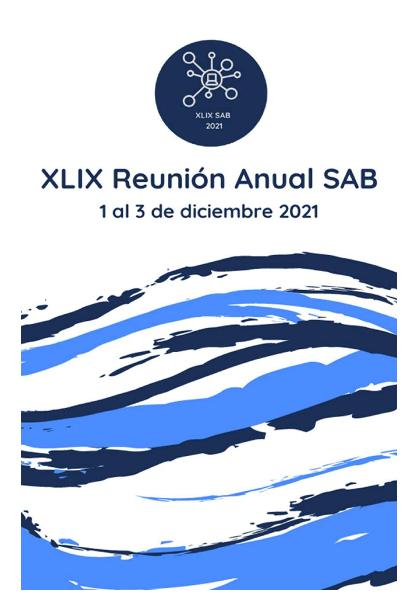Mostrar el registro sencillo del ítem
dc.contributor.author
Colmano, Guillermo Nicolas

dc.contributor.author
Sánchez, Mariela Eugenia

dc.contributor.author
Turina, Anahi del Valle

dc.contributor.other
Delfino, Jose Maria

dc.contributor.other
Celej, Maria Soledad

dc.contributor.other
Mangialavori, Irene Cecilia

dc.contributor.other
Acierno, Juan Pablo

dc.date.available
2023-02-13T15:25:53Z
dc.date.issued
2021
dc.identifier.citation
Natural membranes: Lipidomic, membrane fluidity and phospholipid order; XLIX Reunión Anual de la SAB; Ciudad Autónoma de Buenos Aires; Argentina; 2021; 63-63
dc.identifier.isbn
978-987-27591-9-3
dc.identifier.uri
http://hdl.handle.net/11336/187758
dc.description.abstract
Biological membranes are complex assembles constituted by a wide variety of lipids and proteins. It is generally accepted that biological membranes have lateral heterogeneity derived from non-homogeneous distribution of their components and are usually assumed as coexisting liquid disordered- liquid-ordered phases. In this study, the lipid composition of Bos taurus (Bt) synaptosomal membranes and Triatoma infestans (Ti) ganglionic membranes was determined by HPLC-MS/MS. Membrane order and fluidity of whole natural membranes (NMs) and extracted lipids membranes (LMs) was evaluated by Laurdan generalized polarization (GP) and anisotropy (A) determinations in steady state florescence spectroscopy experiments. There are no reports neither about the lipid composition of NMTi nor biophysical studies of them. Also, we analyzed a 4-lipid component model membrane (BMs) as a potential biomimetic membrane of the lipid fraction of the natural membranes. LMs were obtained by a modified Blight & Dyer partition, the content of PC, PE, PS, SM, PG, PI, and Sterols was determined. We observed that in LMBt, PC polar group was the most abundant, with 18C fatty acids and 2 unsaturations being the most frequent. On the other hand, LMTi had PE as the main polar group, with 18C fatty acids and 3 unsaturations being the most common. A 14/28% of plasmalogen was detected and 17/11% of sterols respectively. It was observed that in all cases Laurdan GP values and anisotropy diminish with temperature increase and that the values of NMTi are lower than those of NMBt. This result is in accord with a previous report with DPH probe and with the sterol % present in each membrane. Laurdan fluorescence spectra were compared at physiologically relevant temperatures (37°C for Bt and 28°C for Ti) and was observed that both the NMs and LMs presented similar λmax values (434nm for Bt and 436nm for Ti) with a 490nm shoulder in both cases, suggesting phase coexistence. BMBt were capable of simulate the order of NMBt and LMBt since their anisotropy values were similar. However, BMTi showed higher anisotropy values meaning a more ordered membrane. Interestingly, GP and anisotropy values obtained at relevant temperatures were similar for NMs and LMs pointing to a conserved compensation balance between cholesterol and PE content that might be needed for membrane fluidity control in the NMs studied as was proposed in bibliography.
dc.format
application/pdf
dc.language.iso
eng
dc.publisher
Sociedad Argentina de Biofísica
dc.rights
info:eu-repo/semantics/openAccess
dc.rights.uri
https://creativecommons.org/licenses/by-nc-sa/2.5/ar/
dc.subject
NATURAL MEMBRANES
dc.subject
LIPIDOMIC
dc.subject
TRIATOMA INFESTANS
dc.subject
BOS TAURUS
dc.subject.classification
Biofísica

dc.subject.classification
Ciencias Biológicas

dc.subject.classification
CIENCIAS NATURALES Y EXACTAS

dc.title
Natural membranes: Lipidomic, membrane fluidity and phospholipid order
dc.type
info:eu-repo/semantics/publishedVersion
dc.type
info:eu-repo/semantics/conferenceObject
dc.type
info:ar-repo/semantics/documento de conferencia
dc.date.updated
2022-11-09T16:12:52Z
dc.journal.pagination
63-63
dc.journal.pais
Argentina

dc.journal.ciudad
Buenos Aires
dc.description.fil
Fil: Colmano, Guillermo Nicolas. Consejo Nacional de Investigaciones Científicas y Técnicas. Centro Científico Tecnológico Conicet - Córdoba. Instituto de Investigaciones Biológicas y Tecnológicas. Universidad Nacional de Córdoba. Facultad de Ciencias Exactas, Físicas y Naturales. Instituto de Investigaciones Biológicas y Tecnológicas; Argentina. Universidad Nacional de Córdoba. Facultad de Ciencias Exactas, Físicas y Naturales. Departamento de Química. Cátedra de Química Biológica; Argentina
dc.description.fil
Fil: Sánchez, Mariela Eugenia. Consejo Nacional de Investigaciones Científicas y Técnicas. Centro Científico Tecnológico Conicet - Córdoba. Instituto de Investigaciones Biológicas y Tecnológicas. Universidad Nacional de Córdoba. Facultad de Ciencias Exactas, Físicas y Naturales. Instituto de Investigaciones Biológicas y Tecnológicas; Argentina. Universidad Nacional de Córdoba. Facultad de Ciencias Exactas, Físicas y Naturales. Departamento de Química. Cátedra de Química Biológica; Argentina
dc.description.fil
Fil: Turina, Anahi del Valle. Consejo Nacional de Investigaciones Científicas y Técnicas. Centro Científico Tecnológico Conicet - Córdoba. Instituto de Investigaciones Biológicas y Tecnológicas. Universidad Nacional de Córdoba. Facultad de Ciencias Exactas, Físicas y Naturales. Instituto de Investigaciones Biológicas y Tecnológicas; Argentina. Universidad Nacional de Córdoba. Facultad de Ciencias Exactas, Físicas y Naturales. Departamento de Química. Cátedra de Química Biológica; Argentina
dc.relation.alternativeid
info:eu-repo/semantics/altIdentifier/url/https://biofisica.org.ar/reuniones-cientificas/reunionsab-previas/
dc.conicet.rol
Autor

dc.conicet.rol
Autor

dc.conicet.rol
Autor

dc.coverage
Nacional
dc.type.subtype
Reunión
dc.description.nombreEvento
XLIX Reunión Anual de la SAB
dc.date.evento
2021-12-01
dc.description.ciudadEvento
Ciudad Autónoma de Buenos Aires
dc.description.paisEvento
Argentina

dc.type.publicacion
Book
dc.description.institucionOrganizadora
Sociedad Argentina de Biofísica
dc.source.libro
XLIX Reunión Anual SAB
dc.date.eventoHasta
2021-12-03
dc.type
Reunión
Archivos asociados
